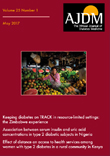Navigating the critical terrain of hyperosmolar diabetic ketoacidosis
*Corresponding Author:
Received: 29-Nov-2023, Manuscript No. ajdm-24-125398 ; Editor assigned: 01-Dec-2023, Pre QC No. ajdm-24-125398 (PQ); Reviewed: 15-Dec-2023, QC No. ajdm-24-125398; Revised: 20-Dec-2023, Manuscript No. ajdm-24-125398 (R); Published: 27-Dec-2023, DOI: 10.54931/AJDM-31.6.6.
Introduction
Diabetic Ketoacidosis (DKA) is a well-known and serious complication of diabetes, but there exists a less commonly discussed yet equally critical variant known as Hyperosmolar Diabetic Ketoacidosis (HDKA). Hyperosmolar diabetic ketoacidosis is an acute and potentially life-threatening complication that primarily affects individuals with type 2 diabetes, often occurring in the setting of extreme hyperglycemia. Unlike classic DKA, HDKA is characterized by higher serum glucose levels and profound dehydration, overshadowing the presence of ketosis. HDKA is distinguished by markedly elevated blood glucose levels, often exceeding 600 mg/dL. The extreme hyperglycemia results in an osmotic diuresis, leading to significant fluid loss. Profound dehydration is a hallmark of HDKA, manifesting as dry mucous membranes, reduced skin turgor, and altered mental status ranging from confusion to coma. This severe dehydration can lead to hypovolemic shock if not promptly addressed. Unlike classic DKA, HDKA may exhibit only mild to moderate ketosis or even an absence of ketones in the urine. The primary focus in HDKA is the hyperosmolarity and dehydration. HDKA is more commonly observed in individuals with type 2 diabetes, often in the elderly population. Older individuals, especially those with comorbidities such as cardiovascular disease or renal impairment, are at an increased risk of HDKA.
Description
Conditions associated with insulin resistance, such as obesity, contribute to the development of HDKA. Limited access to water or impaired thirst mechanisms, common in the elderly, can exacerbate dehydration. Concurrent illnesses, particularly infections, can precipitate HDKA by increasing insulin resistance and exacerbating hyperglycemia. Fluid Resuscitation, Prompt and aggressive fluid replacement is the cornerstone of HDKA management. Intravenous fluids, typically isotonic saline, are administered to correct dehydration and improve hemodynamic stability. Insulin administration is essential to address hyperglycemia. Continuous intravenous insulin infusion is often preferred over subcutaneous insulin due to its rapid onset and easier titration. Frequent monitoring of electrolyte levels, especially potassium, is crucial as insulin therapy can lead to shifts in electrolyte balance. Identifying and addressing underlying causes, such as infections or noncompliance with medications, is essential for comprehensive management. Continuous monitoring of blood glucose, electrolytes, and renal function is necessary to ensure appropriate responses to treatment. Hyperosmolar diabetic ketoacidosis poses a significant threat to individuals with diabetes, particularly those with type 2 diabetes. Recognizing its distinctive features, understanding the associated risk factors, and implementing prompt and targeted interventions are paramount for successful management. As healthcare professionals and communities enhance awareness of HDKA, early recognition and intervention can mitigate the potentially life-threatening consequences, ultimately contributing to improved outcomes for those facing this critical diabetic complication.
Conclusion
Multidisciplinary collaboration, involving endocrinologists, intensivists, and other specialists, plays a Prevention of HDKA requires ongoing patient education on diabetes self-management, regular monitoring of blood glucose levels, and timely adjustments to insulin regimens. Recognizing the potential triggers, such as infections or changes in medication, empowers individuals to proactively manage their diabetes and reduce the risk of complications like HDKA. Furthermore, the role of family members and caregivers is pivotal in providing support and ensuring adherence to treatment plans. Raising awareness about HDKA within the community can contribute to early recognition of symptoms, prompting timely medical intervention and potentially preventing severe complications.





